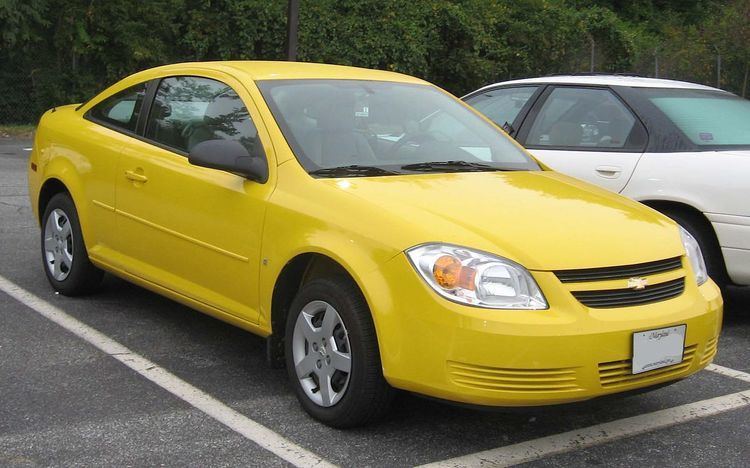Production 2004–2010 Designer Phil Zak | Model years 2005–2010 | |
 | ||
Also called Pontiac G4 (Mexico, 2005–06)Pontiac G5 Pursuit (2006, Canada)Pontiac Pursuit (2005–06, Canada)Pontiac G5 (2007–10) Assembly | ||
The Chevrolet Cobalt is a compact car initially introduced by Chevrolet in 2004 for the 2005 model year. The Cobalt replaced both the Cavalier and the Toyota-based Prizm (discontinued 3 years earlier) as Chevrolet's compact car. The Cobalt was available as both a coupe and sedan, and is based on the GM Delta platform also shared with the Chevrolet HHR wagon and Saturn Ion. Also available was a high performance, Super Sport variant.
Contents
A Pontiac version was sold primarily as the Pontiac G5 in Canada for its entire run (where it was briefly known as the Pontiac Pursuit and later Pontiac G5 Pursuit), as well as the Pontiac G4 in Mexico for 2005–2006, and in both Mexico and the United States under the G5 name for 2007–2009. In all cases, the G5 replaced the Cavalier-related Pontiac Sunfire. While the Cobalt was available as a 2-door coupé and a 4-door sedan in all markets it was offered in, the G5 was only available as a coupé in the United States while a sedan version was sold alongside the coupé in Canada and Mexico.
As with their predecessors, all Cobalts and its Pontiac equivalents were manufactured at GM's plant in Ramos Arizpe, Mexico and Lordstown, Ohio. The United States Environmental Protection Agency classifies the Cobalt as a subcompact car.
Specifications
The front suspension is independent with MacPherson struts, while a semi-independent torsion beam is used in the rear. The wheelbase is 103.3 in (2,624 mm), longer than its competitors, and the width is 68.4 in (1,737 mm). Weight is average in-class, at 2,681 lb (1,216 kg) for the coupe and 2,747 lb (1,246 kg) for the sedan. For 2009, the United States Environmental Protection Agency fuel economy was increased to 24 mpg‑US (9.8 L/100 km; 29 mpg‑imp) city/34 mpg‑US (6.9 L/100 km; 41 mpg‑imp) highway with automatic transmission, and 26 mpg‑US (9.0 L/100 km; 31 mpg‑imp) city/37 mpg‑US (6.4 L/100 km; 44 mpg‑imp) highway with manual transmission. The engine output was increased to 155 hp (116 kW).
Year-to-year changes
Safety
According to the Insurance Institute for Highway Safety (IIHS) the Cobalt receives an overall top score of "Good" for front collisions. However, it receives a "Poor" overall score for side impacts without side curtain airbags, and an "Acceptable" overall score with side curtain airbags. In 2008 side curtain airbags became standard but the Cobalt's structure remains the same and consequently in structure/safety category of the IIHS's side impact test the Cobalt receives a "Marginal" score. Side airbags are limited to the curtain type, torso type side airbags are unavailable. According to the IIHS's injury measurements taken from the side impact test the driver's torso is given a "Marginal" score.
The IIHS also found 2005-08 model year Cobalts had the highest fatality rate in the small 4 door car class, with 117 deaths per million registered years compared to its class average of 71.
2010 NHTSA sedan crash test:
Before 2009 the Cobalt only offered stability control as an option on Sport models.
Defects and recalls
In early 2007, 98,000 Cobalt coupes from the 2005–06 model years were recalled after it was discovered they did not meet federal safety requirements because of a lack of adequate padding in a specific area of the vehicle's trim. This resulted in an unacceptable vulnerability to head injuries, though GM claimed the vulnerability would only affect motorists not wearing a seat belt.
On March 2, 2010, GM announced a recall of 1.3 million compact cars in North America, including the Chevrolet Cobalt, because of power steering problems. GM plans on fixing older models before fixing current models, as the car was replaced by the Chevrolet Cruze in late 2010. The Pontiac G5 and its international variants were also affected, though GM had already ended production of the Pontiac brand by that point. The following recall is due to extreme heat causing damage to the plastic fuel pump lines. On September 28, 2012, GM announced a recall of 40,859 cars including the Chevrolet Cobalt from the 2007-09 model year because of a potential fuel leak.
Faulty ignition switches in the Cobalts, which cut power to the car while in motion, were eventually linked to many crashes resulting in fatalities, starting with a teenager in 2005 who drove her new Cobalt into a tree. The switch continued to be used in the manufacture of the vehicles even after the problem was known to GM. On February 21, 2014, GM recalled over 700,000 Cobalts for issues traceable to the defective ignition switches. In May 2014 the NHTSA fined the company $35 million for failing to recall cars with faulty ignition switches for a decade, despite knowing there was a problem with the switches. Thirteen deaths were linked to the faulty switches during the time the company failed to recall the cars.
Replacement
In 2009, Chevrolet launched the Cobalt's eventual successor, the Chevrolet Cruze (based on the new Delta II platform), in Europe, with launches in other markets (including the US) following in 2010. The Cobalt ended production on June 23, 2010. With the discontinuation of the Pontiac brand by GM in 2010, the Buick Verano is marketed as the G5's successor in Canada, while the Cruze serves as a de facto replacement for the Pontiac G5 in America.
